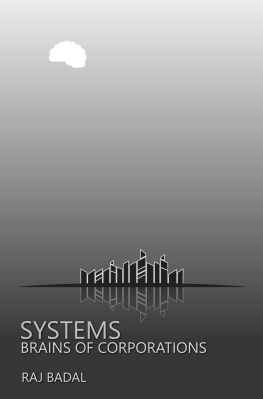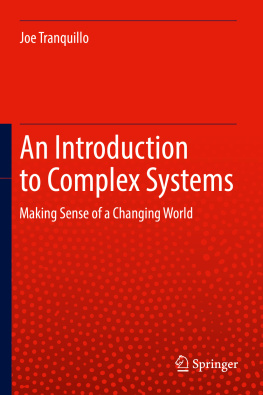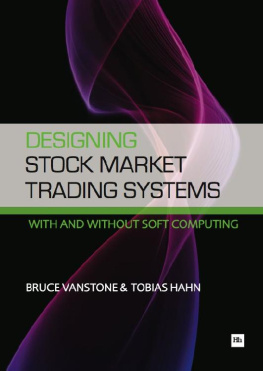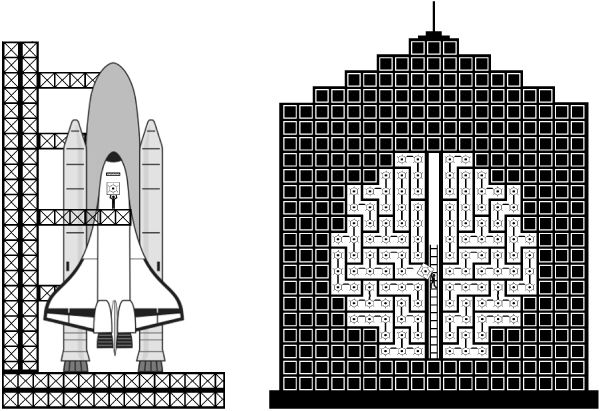SYSTEMS
BRAINS OF CORPORATIONS
Copyright 2016 by Raj Badal
Text, illustrations, cover, and book design by Raj Badal
All rights reserved. In accordance with the U.S. Copyright Act of 1976, the scanning, uploading, and electronic sharing of any part of this book without the permission of the author constitute unlawful piracy and theft of the author's intellectual property. If you would like to use material from the book (other than for review purposes), prior written permission must be obtained by contacting the author at .
www.twitter.com/brainsofcorp. First ebook edition: February 2016 The author is not responsible for websites (or their content) that are not owned by the author.ISBN: 978-1-944786-48-9
For my mother master of efficiency
and my father master of discipline.
Two roads diverged in a wood and I - I took the one less traveled by, and that has made all the difference.
Robert Frost
CONTENTS
If we want to go to space with humans, thats for fun not for science. Human adventures in space are just sporting events.
Freeman Dyson
It is Corporate Science
Space the Costly Frontier
M ay 27, 2035. SNN Breaking News
Hello viewers, this is Kelly Jones reporting from SNN headquarters. We have just received breaking news from the Department of Energy (DoE). Only on: Science News Network (SNN)! Scientists from the DoE claim to have found a solution to the worlds energy problem. That solution is Energium, the unknown metal that can provide nuclear energy without any radioactive waste. If you recall our last news segment in this matter, Energium is the metal discovered by NASAs probe Callistover, which landed on Jupiters moon Callisto a few months ago. National Aeronautics and Space Administration (NASA) was able to extract five kilograms of pure Energium from Callisto. According to SNNs Chief Science reporter, even a small amount of this precious metal can meet the energy requirement of the US for the next three months. And without any radioactive waste!
Yes, you heard it right, for three months! Lets talk to the Energy Secretary John Smith about this ground breaking discovery. Good evening, Mr. Smith! So is it true that Energium is the solution to the worlds power?
Energy Secretary: Good evening Kelly, although these are early results, we are convinced that Energium can solve the Energy problem, not only in the US but all over the World.
Reporter: How can we get this this extraordinary metal?
Energy Secretary: Currently, there is no way to manufacture this precious metal. It is available only on the moon of the largest planet in our solar system Jupiter.
Reporter: How much Energium is available on Callisto?
Energy Secretary: I cannot say for sure, but it seems that Callistos lower region, approximately the size of the state of Texas, is full of Energium.
Reporter: Thank you, Mr. Secretary! Back to our SNN headquarters now! Here, we have a panel of experts, who will discuss this remarkable discovery. First, I would like to invite NASAs chief engineer, Mr. Cosmos, involved with project Callistover. Mr. Cosmos, what do you think the US should do next?
Mr. Cosmos: Well, I think the US should grab this opportunity and lead another mission to Callisto. We should be the first to bring back this precious metal Energium back to our planet. I would say within less than a decade we will be supplying power to the rest of the world.
Reporter: Interesting! So, some of these science fiction writers were right. We are probably going to mine other planets. Hmm Are we going to send a team of scientists and workers to Callisto?
Mr. Cosmos: I sincerely doubt that. We can send an unmanned space probe to get this metal from Callisto. We do not need to send people.
Reporter: Why can we not send people to other planets if we can solve the Worlds energy issue? We have sent astronauts to Moon and Space.
Mr. Cosmos: Sending people to Callisto will be extremely expensive as compared with the probe. Besides, we have already accomplished a successful mission to Callisto. Callistover took two years to reach Callisto and came back after almost four years. We do not have the technology and resources for people to stay on a space ship for more than four years. However, we do have the technology to build and launch an unmanned spacecraft. The Spacecraft can be remote controlled, remote guided, or even auto guided.
Reporter: Do you think other countries will jump on this opportunity?
Mr. Cosmos: Definitely! In this age of global competition, other countries will do everything in their power to bank on this Energy Revolution. In fact, European Union, Russia, China, India, and Japan already possess the technology to build such probes.
And, the debate continues...
The mysteries of the universe, space, and the origin of Earth continue to intrigue mankind. The first project to launch a man in space began in April 1961 by Russia, formerly USSR. Thus, the early space age began in the 1960s between the two superpower nations - USA and Russia. Their primary aim as space pioneers was prestige and power, in addition to defense and security. The USA created the Apollo space program with the goal of landing a man on the Moon and returning him safely to the Earth and thus, won the race to being a space nation. However, landing on the moon was not cheap: The US shelled out approximately 2.5% of the total Federal Budget for twelve years.
How expensive was the space program?
In terms of the year 2007 dollars, the total amount was $268 billion dollars. On April 11, 1970, NASA launched the seventh manned mission, Apollo 13, which intended to land on the moon. However, two days later (Houston, weve got a problem) the mission was aborted when an oxygen tank exploded. Subsequently, in 1970, three Apollo missions 18 to 20 were canceled because of budgetary constraints. The next years (1971) budget for NASA was 1.61% of the Federal budget. However, at its peak in 1966, it was 4.41% ($32 billion). Since then, NASAs budget has shrunk to 0.48% (around $17 Billion) of the Federal budget in the year 2012.
It has been more than fifty years since the space age began. Today, the global economy has involved many nations and corporations in the space game - the plans consist of landing on other planets, moon, or asteroids. Almost all of them are experimental without any significant economic reason for the visit. Governments fund these projects to explore, discover, and experiment. As of 2014, only Russia and China have human space programs and are independent of any international cooperation. However, most projects involve launching unmanned probes into space.
Where are these space programs headed after 50 years of experimentation? President Obama addressed this issue in the National Space Policy of USA.
Fifty years after the creation of NASA, our goal is no longer just a destination to reach. Our goal is the capacity for people to work and learn and operate and live safely beyond the Earth for extended periods of time, ultimately in ways that are more sustainable and even indefinite. And in fulfilling this task, we will not only extend humanitys reach in space - we will strengthen Americas leadership here on Earth.
-President Barack Obama, April 15, 2010
I agree with the first sentence of the President! However, I believe that the second goal conflicts with the first objective. If our goal is no longer just a destination, why do we want to invest in a technology that will allow people to live beyond Earth for extended periods of time? Is that the destination we have in mind? The question we need to answer, not only for the USA, but for the whole world is: What is the purpose of the space program?












